Optimization of Multi-Objective Process Parameters and Performance Analysis of High-Speed Laser Cladding of TC4/AISI431 Composite Coatings
Abstract
1. Introduction
2. Experimental Materials and Methods
2.1. Coating Equipment and Materials
2.2. Experimental Methods
2.2.1. Porosity
2.2.2. Microhardness
2.2.3. Electrochemical Corrosion Resistance
2.3. Regression Analysis and Significance Analyses
2.4. Effects of Interactions Between Factors on Experimental Indicators
3. WOA Multi-Objective Process Parameter Optimization
Determination of the Optimal Solution
4. Results and Discussion
4.1. EDS Surface Scanning Results of the Coating Surface
4.2. Parameter Optimization Experiment Comparison
5. Conclusions
Author Contributions
Funding
Institutional Review Board Statement
Informed Consent Statement
Data Availability Statement
Conflicts of Interest
References
- Liu, Y.; Xiang, D.; Wang, K.; Yu, T. Corrosion of Laser Cladding High-Entropy Alloy Coatings: A Review. Coatings 2022, 12, 1669. [Google Scholar] [CrossRef]
- John, M.; Kuruveri, U.B.; Menezes, P.L. Laser Cladding-Based Surface Modification of Carbon Steel and High-Alloy Steel for Extreme Condition Applications. Coatings 2022, 12, 1444. [Google Scholar] [CrossRef]
- Yuan, W.; Li, R.; Chen, Z.; Tian, Y. A Comparative Study on Microstructure and Properties of Traditional Laser Cladding and High-Speed Laser Cladding of Ni45 Alloy Coatings. Surf. Coat. Technol. 2021, 405, 126582. [Google Scholar] [CrossRef]
- Hu, Z.; Li, Y.; Liu, J.; Cai, L.; Tan, N. Research Progress of Ultra-High-Speed Laser Cladding Coating Forming and Key Properties. Laser Optoelectron. Prog. 2023, 60, 0100003. [Google Scholar] [CrossRef]
- Li, M.; Li, C.; Li, B.; Zhou, Y.; Huang, L.; Cai, A.; Cui, C.; Gao, S.; Zhang, G.; Yang, B. Comparison of Fe30Co20Cr20Ni20Mo3.5 High Entropy Alloy Coatings Prepared Using Plasma Cladding, High-Speed Laser Cladding, and Deep Laser Cladding. Coatings 2023, 13, 1819. [Google Scholar] [CrossRef]
- Wang, B.; Li, Q.; Liu, W.; Zhao, Z.; Zhang, D.; Zhang, C.; Guo, J. Study on the Effect of Laser Cleaning on the Surface Quality of Composite Tooling Molds. Matéria 2025, 30, e20240746. [Google Scholar] [CrossRef]
- Wang, S.; Chen, Y.; Gu, C.; Sai, Q.; Lei, T.; Williams, J. Antifouling Coatings Fabricated by Laser Cladding. Coatings 2023, 13, 397. [Google Scholar] [CrossRef]
- Su, X.; Tian, Z.; Chen, X.; Chen, Y.; Li, M.; Du, J.; Tan, Q. Microstructural Characteristics and Mechanical Properties of the Laser Cladded TC4+AlSI10Mg Composite Coating on Carbon Fiber Reinforced Plastic Surface. J. Mater. Res. Technol. 2022, 18, 5312–5324. [Google Scholar] [CrossRef]
- Sun, Y.B.; Niu, H.J.; Wang, J.Y.; Dong, G.F.; Lin, C.X. Microstructure and Corrosion Property of Prepared CoCrW Coatings on the TC4 Surface by Laser Cladding. Coatings 2023, 13, 1687. [Google Scholar] [CrossRef]
- Gong, Y.; Cui, C.; Wu, M.; Miao, X. The Water Droplet Erosion Resistance of Ni-Based Composite Coating through Laser Cladding. Mater. Res. Express 2021, 8, 096524. [Google Scholar] [CrossRef]
- Qin, J.P.; Shu, L.S.; Gong, J.T. Multi-Objective Optimization of Laser Cladding Process of TC4 Coating Based on Hybrid Model. Appl. Laser 2024, 44, 38–45. [Google Scholar]
- Lian, G.; Zhang, H.; Zhang, Y.; Huang, X.; Chen, C.; Jiang, J. Investigation of Geometric Characteristics in Curved Surface Laser Cladding with Curve Path. Metals 2019, 9, 947. [Google Scholar] [CrossRef]
- Gao, Z.; Wang, L.; Wang, Y.; Lyu, F.; Zhan, X. Crack defects and formation mechanism of FeCoCrNi high entropy alloy coating on TC4 titanium alloy prepared by laser cladding. J. Alloys Compd. 2022, 903, 163905. [Google Scholar] [CrossRef]
- Wang, S.; Shao, S.; Bi, S.; Liu, W.; Wu, J.; Yu, W. Study on microstructure and properties of laser cladding Fe-based alloy layer on TC4 surface. Laser Technol. 2022, 46, 5, 653–656. [Google Scholar]
- Ding, Y.; Bi, W.; Zhong, C.; Wu, T.; Gui, W. A Comparative Study on Microstructure and Properties of Ultra-High-Speed Laser Cladding and Traditional Laser Cladding of Inconel625 Coatings. Materials 2022, 15, 6400. [Google Scholar] [CrossRef] [PubMed]
- Ma, C.; Du, W.; Yu, Z.; Zhang, Z.; Zhao, C. The Impact of Pre-Existing Surface Texture on Laser Cladding of 316l Cladding. Manuf. Technol. 2024, 24, 594–607. [Google Scholar] [CrossRef]
- Zhao, C.; Yang, J.; Li, M.; Zhao, Q.; Ma, H.; Jia, X.; Zhang, H. Advances in Surface Laser Cladding Remanufacturing of Shaft Parts. Manuf. Technol. 2023, 23, 564–578. [Google Scholar] [CrossRef]
- Feng, X.; Gu, H.; Zhou, S.; Lei, J. Microstructure and Electrochemical Corrosion Behavior of TC4 Titanium Alloy Cladding Layer Prepared with Powder Feeding Laser Additive Manufacturing. Chin. J. Lasers Zhongguo Jiguang 2019, 46, 0302003. [Google Scholar] [CrossRef]
- Cui, Y.; Xie, C.; Liu, J.; Guo, S.; Cui, L. Mechanical and Corrosion Resistance Analysis of Laser Cladding Layer. Sci. Eng. Compos. Mater. 2022, 29, 358–363. [Google Scholar] [CrossRef]
- Liu, S.; Wang, Q.; Xi, Y.; Tang, Y.; Pei, R.; Bai, S. Effect of Heat Treatment on Mechanical and Anti-Corrosion Properties of Fe-Based Laser Cladded Coatings. Laser Optoelectron. Prog. 2019, 56, 121401. [Google Scholar] [CrossRef]
- Sun, Y.P.; Wang, Z.; Yang, H.J.; Lan, A.D.; Qiao, J.W. Effects of the element La on the corrosion properties of CrMnFeNi high entropy alloys. J. Alloys Compd. 2020, 842, 155825. [Google Scholar] [CrossRef]
- Xie, F.; Zhai, C.S.; Rong, H.S.; Zheng, H.; Zhou, H.; Wu, B.; Zhang, X.; Zhang, Z. Effect of laser cladding power on the electrochemical corrosion performance of FeCrNiCoMoBSi high-entropy alloy coatings. J. Funct. Mater. 2024, 55, 4029–4036. [Google Scholar]
- Ding, X.; Du, X.J.; Ma, X.Y.; Xu, Z.L.; Zhang, W.; He, Y.Z. Corrosion behavior of high corrosion resistant Fe-Cr-Ni medium-entropyalloy in H2SO4 Solution. Mater. Mech. Eng. Ing 2023, 47, 54–60. [Google Scholar]
- Adesina, O.S.; Popoola, A.P.; Farotade, G.A.; Obadele, B.A.; Sanyaolu, O.O.; Jeje, S.O.; Rominiyi, A.L. Effect of Sic Addition on Laser-Based Coni Binary Alloy Coatings on Ti-6al-4v Alloy. Emergent Mater. 2024, 7, 2117–2128. [Google Scholar] [CrossRef]
- Garcia-Blanco, I.; Bozeman, S.C.; Tucker, J.D.; Gonzalez, R.; Isgor, B. Corrosion Behavior of Cobalt-Chromium-Based Laser Claddings Reinforced with Boron Nitride, Graphene Oxide, and Graphite. Adv. Eng. Mater. 2024, 26, 202400863. [Google Scholar] [CrossRef]
- Yang, H.; Cui, J.; Zhou, Y.; Tan, J.; Chen, X.; Huang, G.; Zheng, K.; Jin, Y.; Jiang, B.; Pan, F. Microstructures and the improved mechanical properties of AZ91 alloy by incorporating Ti-6Al-4V particles. J. Mater. Res. Technol. 2023, 26, 7340–7353. [Google Scholar] [CrossRef]
- Wei, D.B.; Zhang, P.Z.; Yao, Z.J.; Liang, W.P.; Miao, Q.; Xu, Z. Oxidation of double-glow plasma chromising coating on TC4 titanium alloys. Corros. Sci. 2013, 66, 43–50. [Google Scholar] [CrossRef]
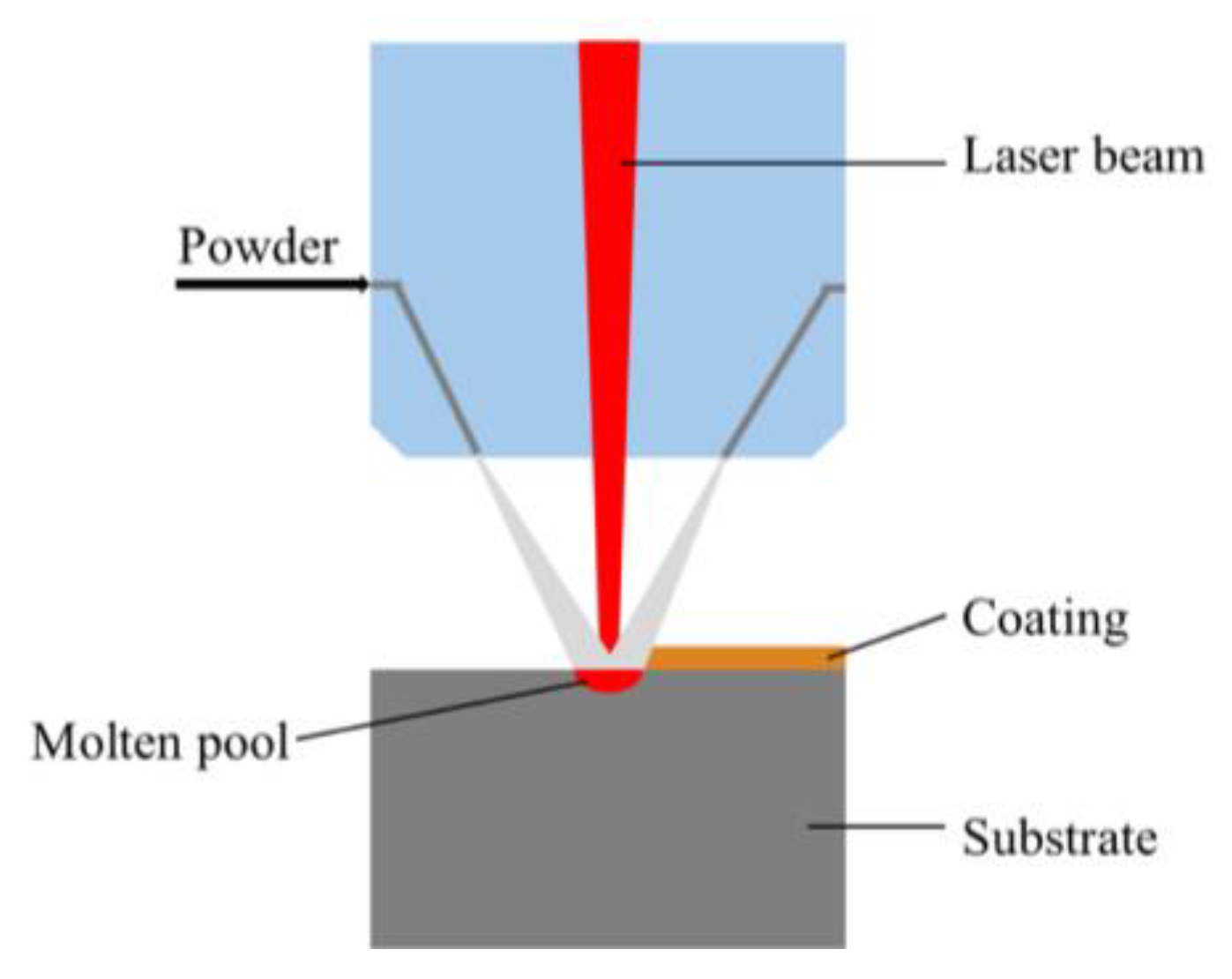
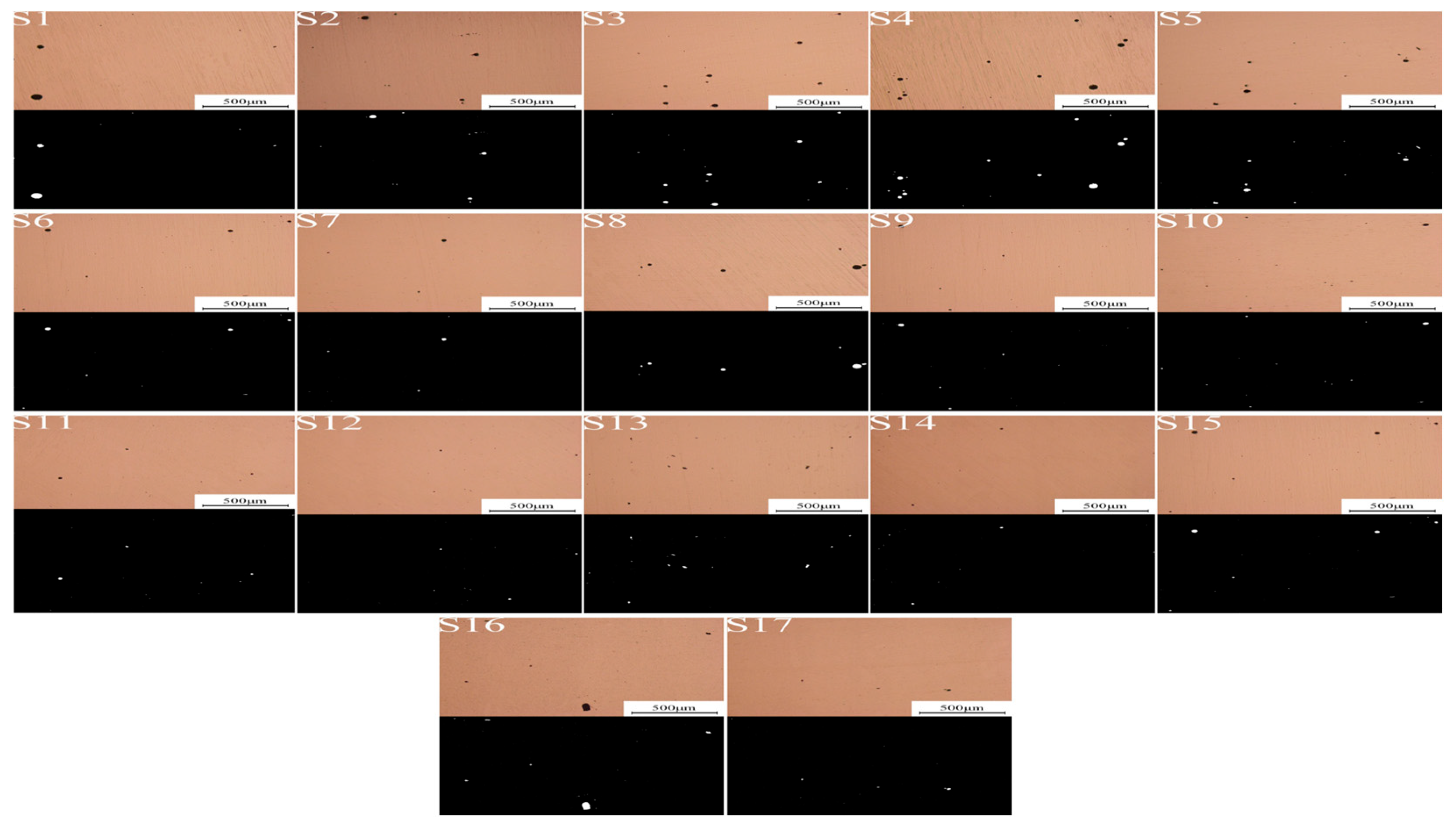
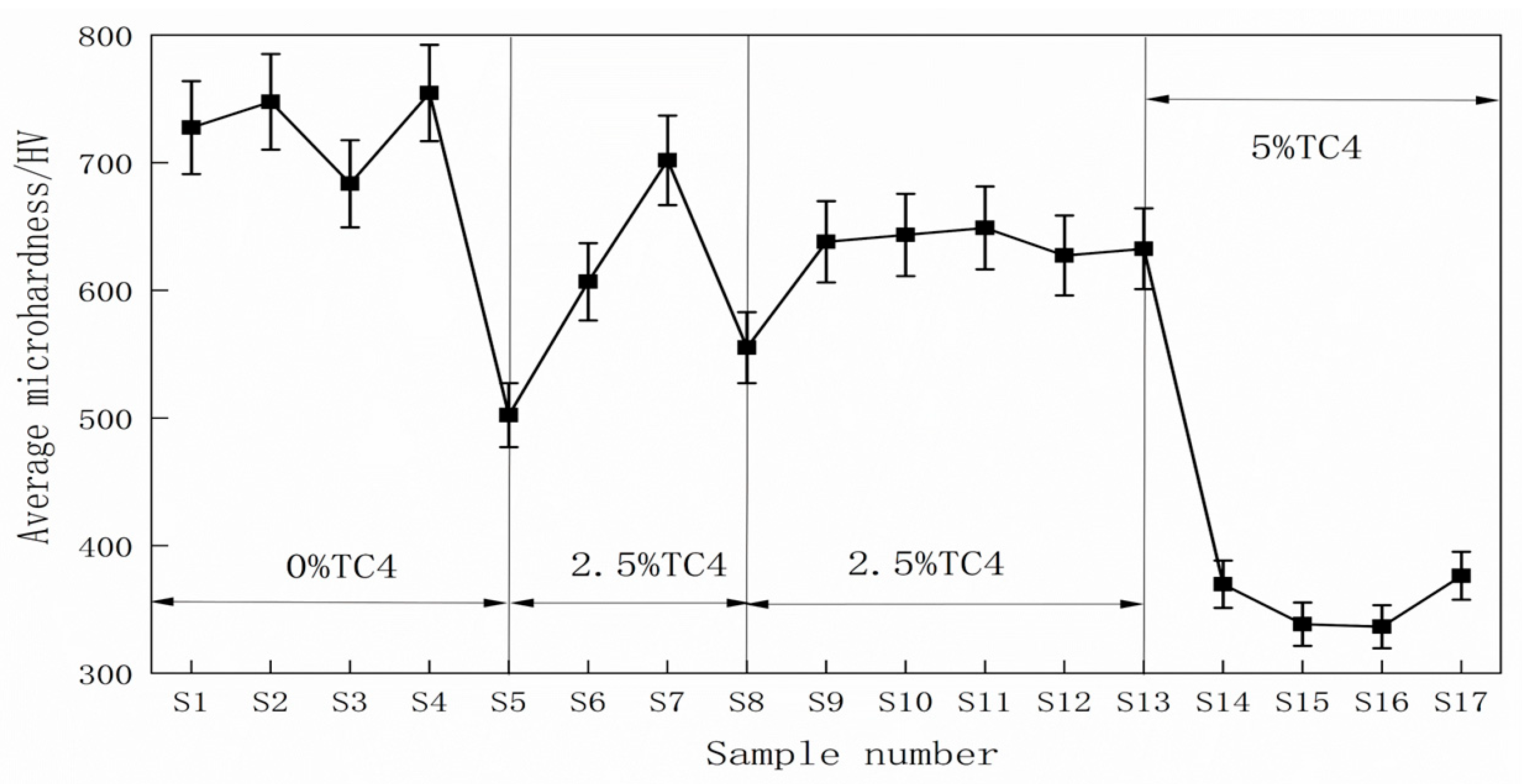
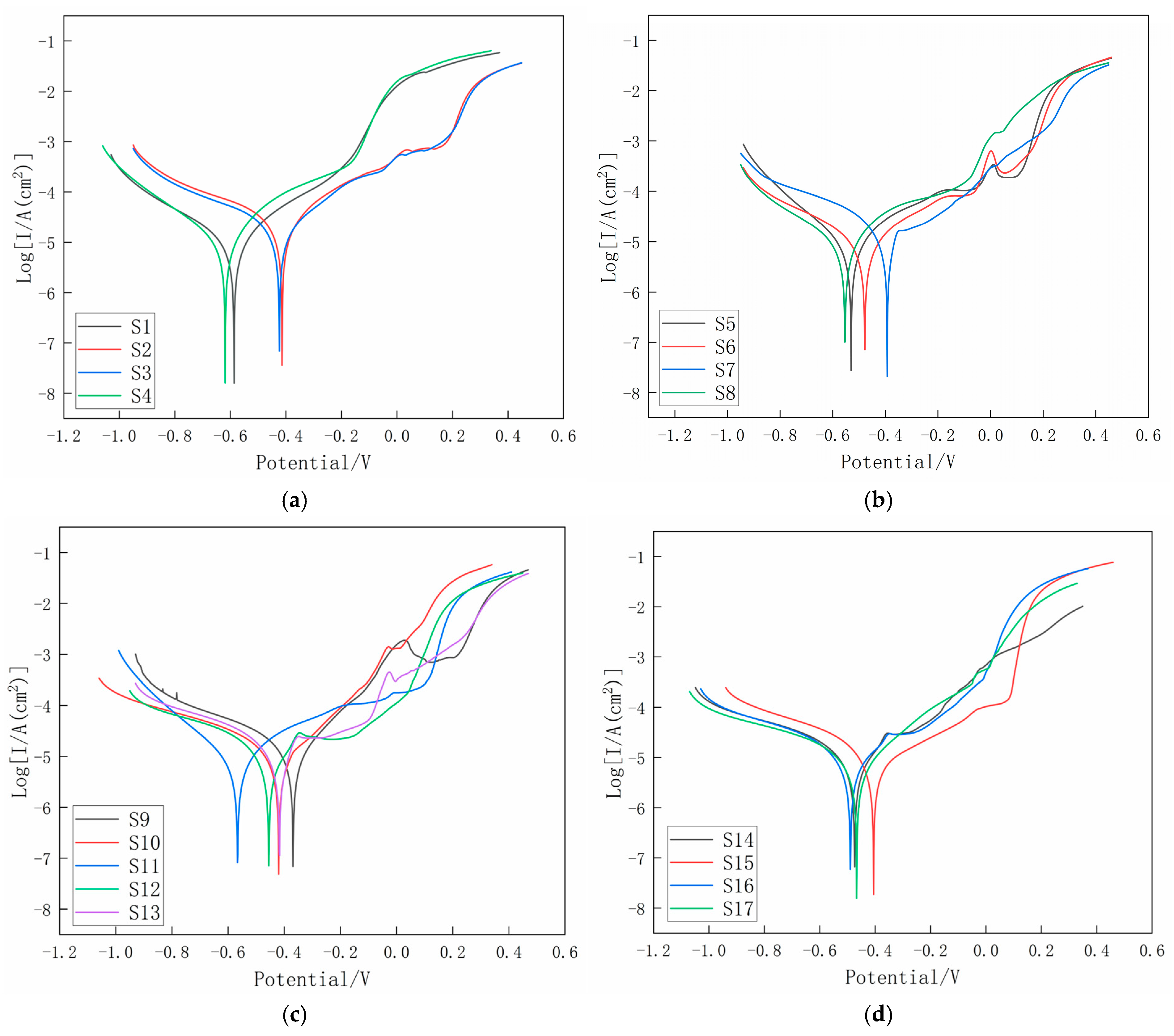

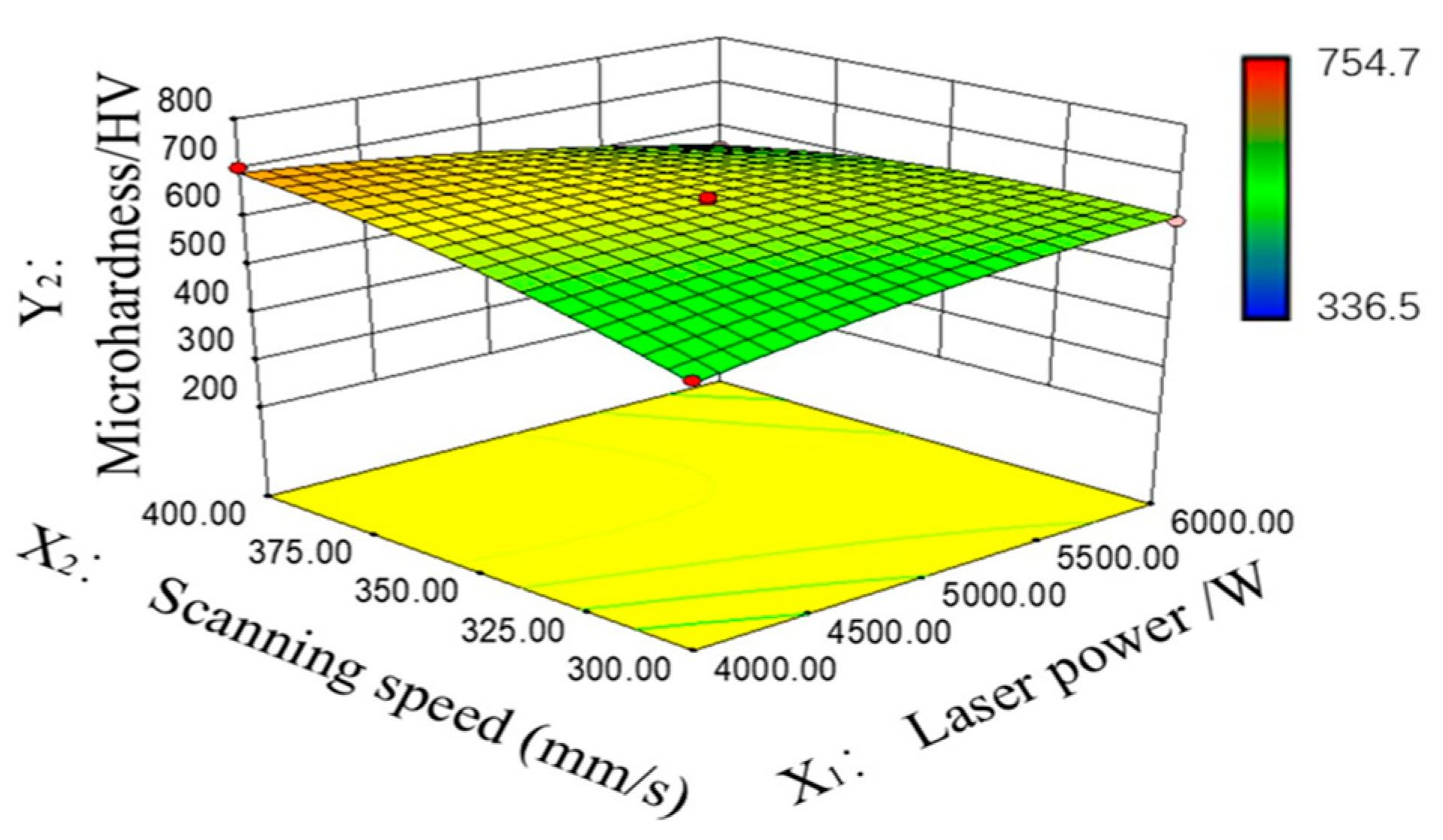
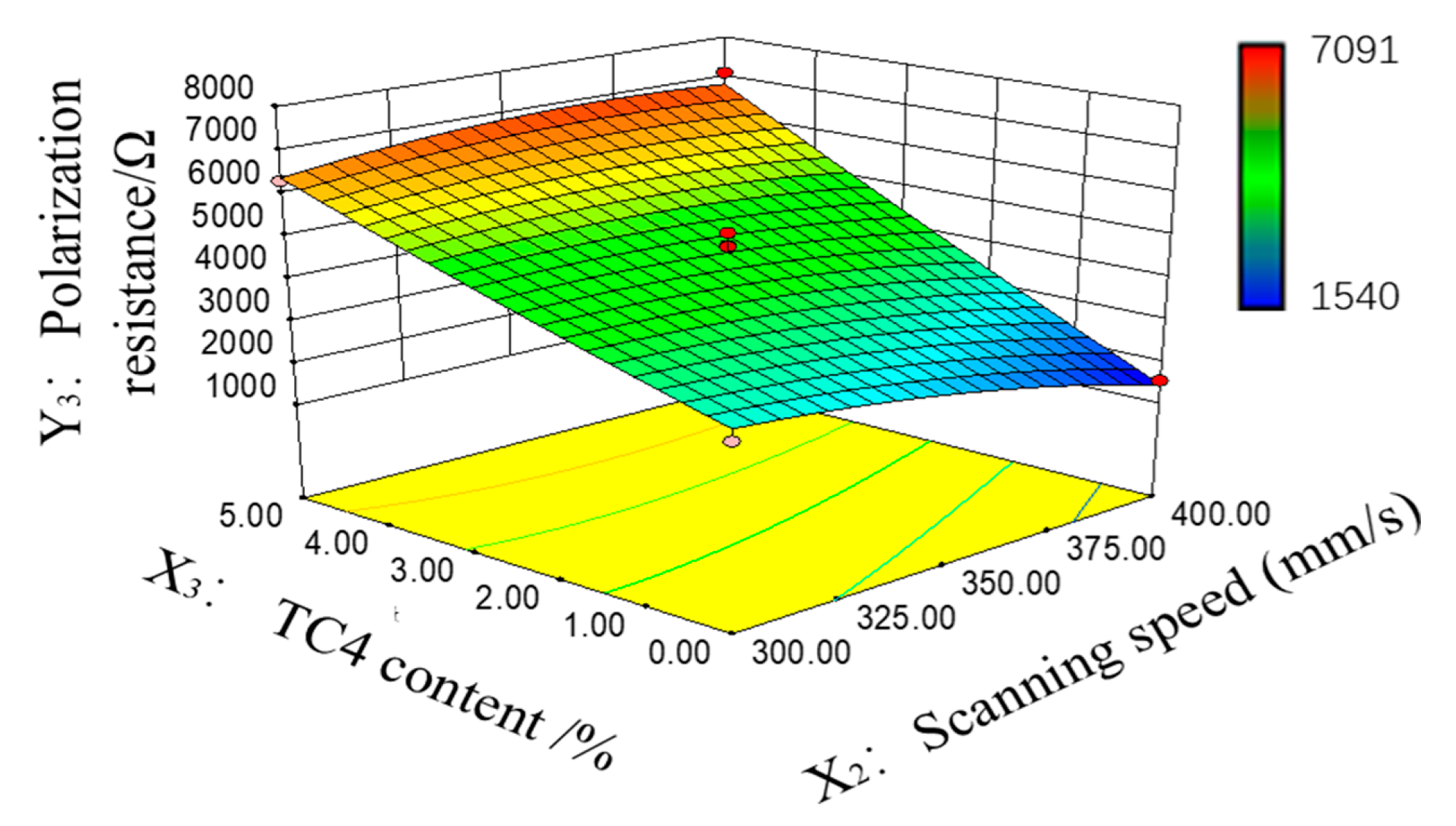
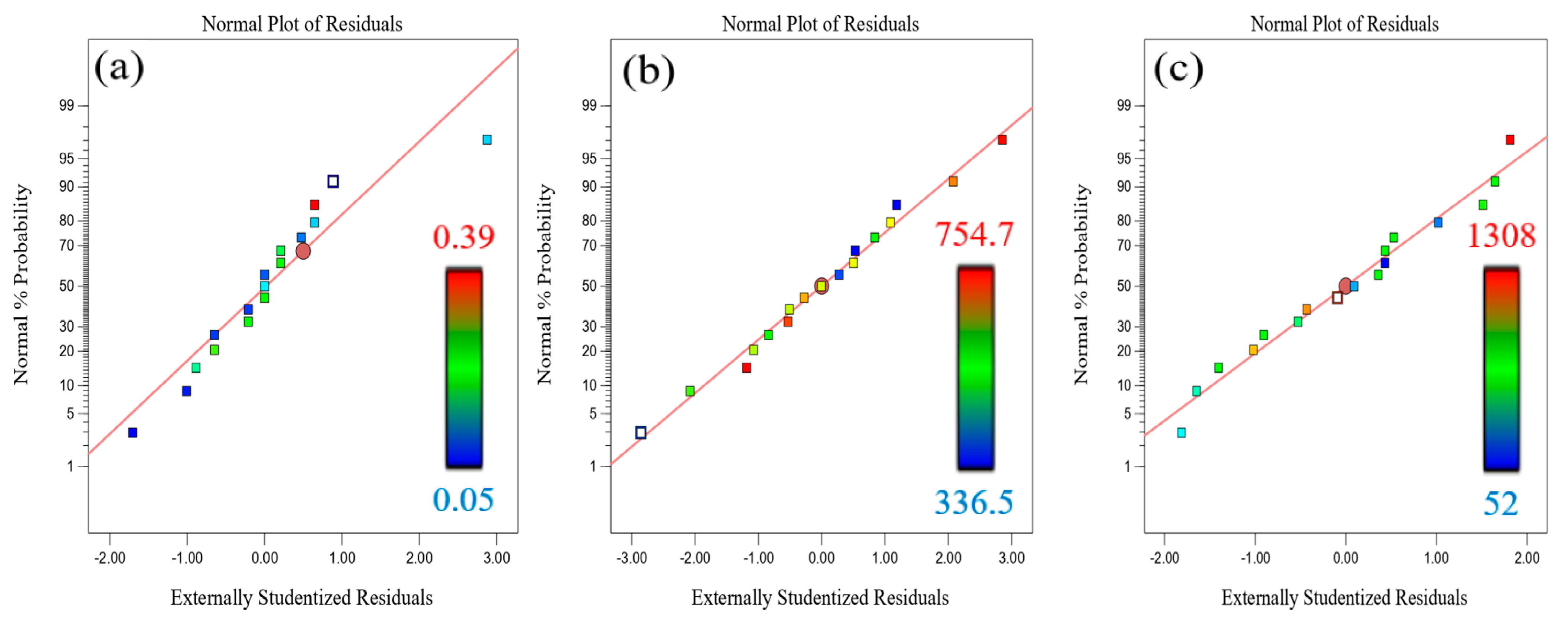
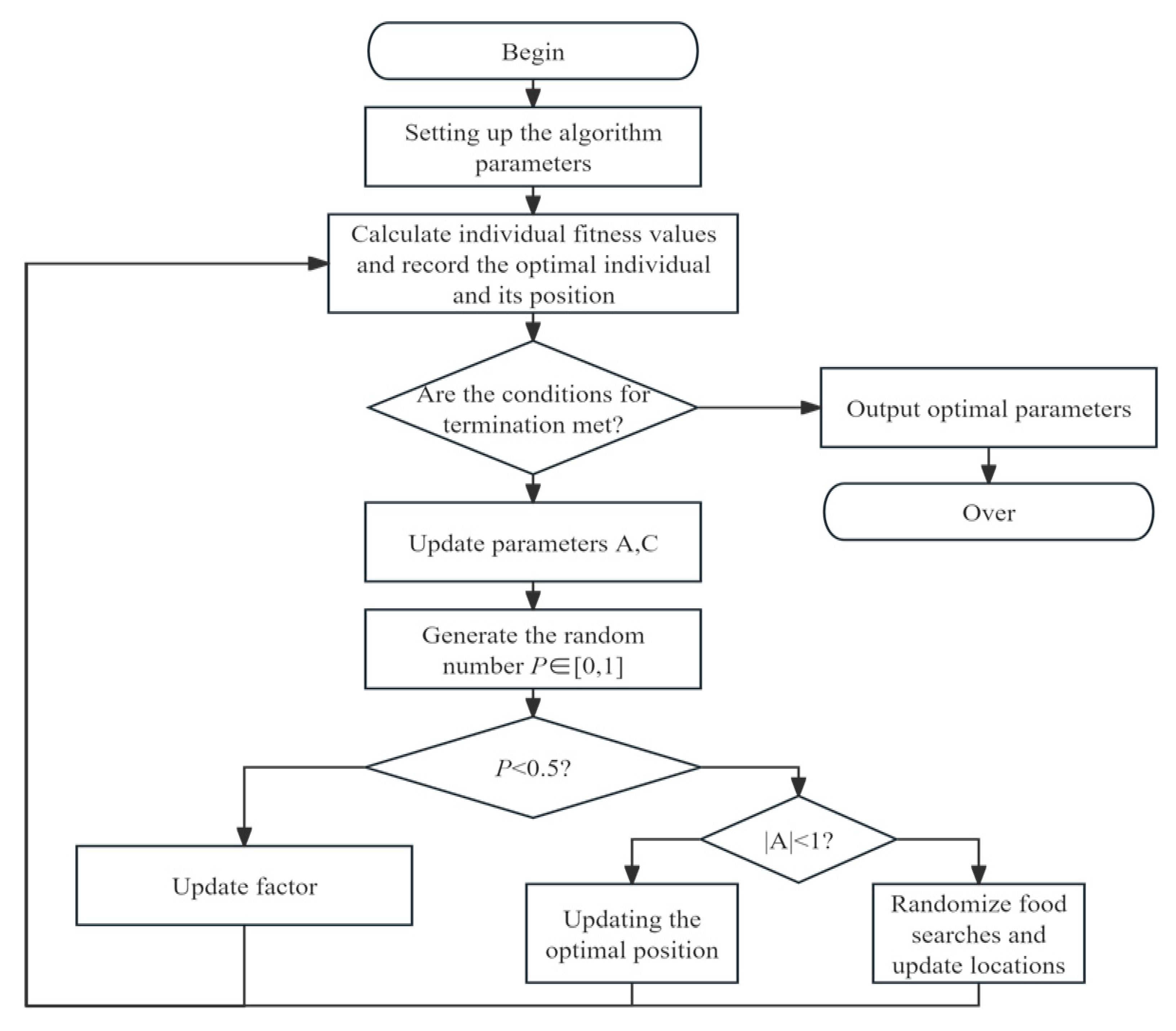
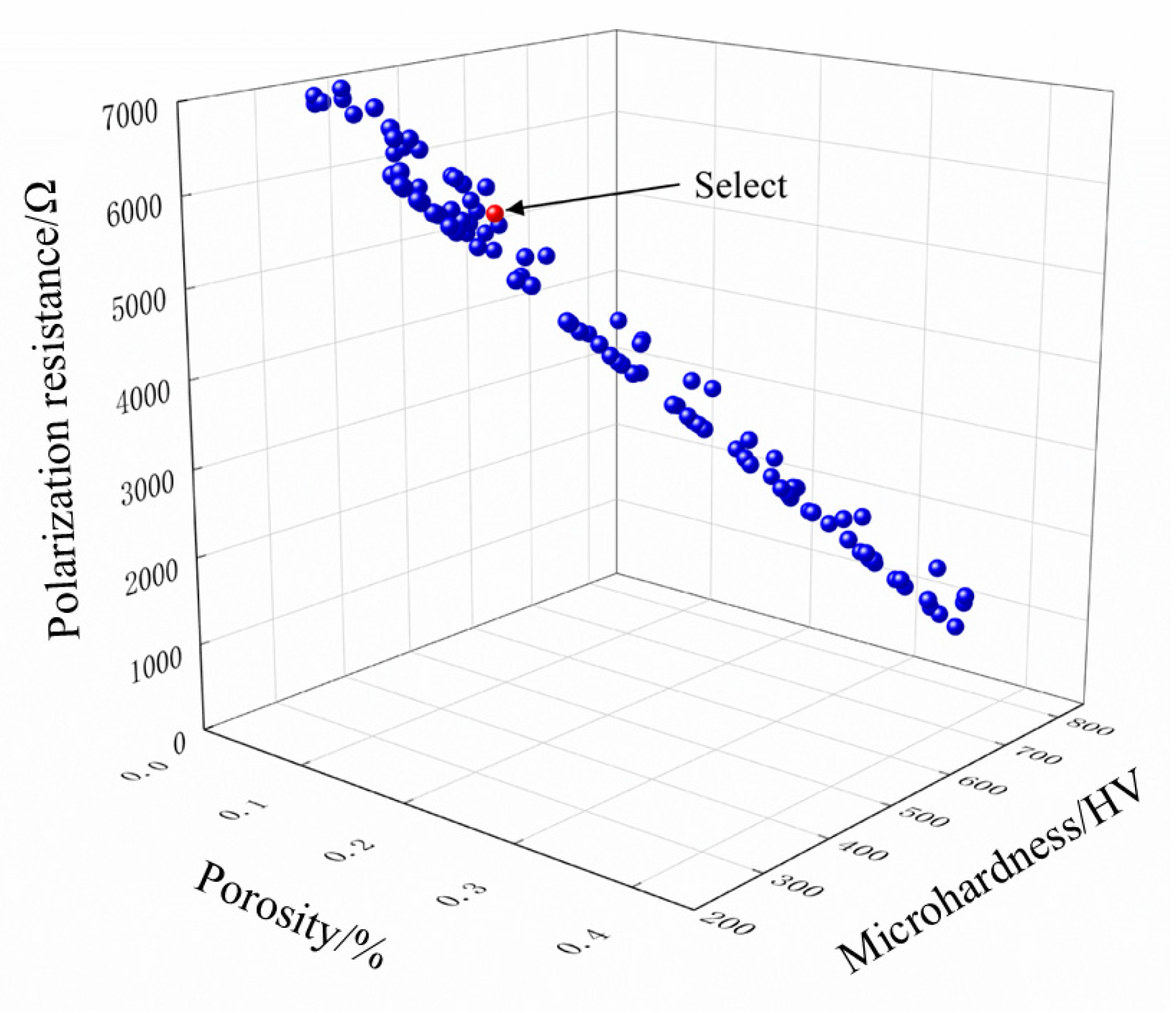
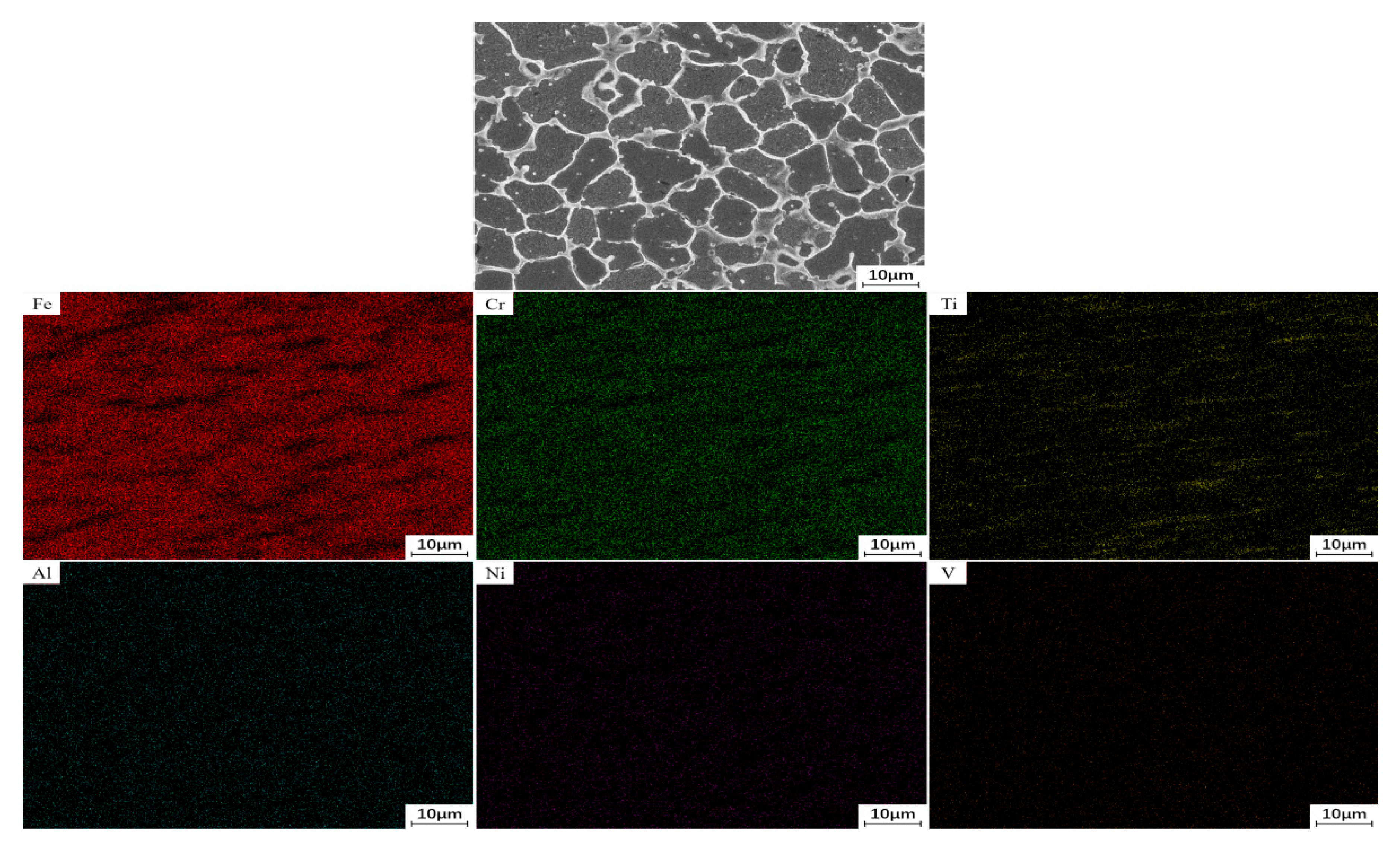
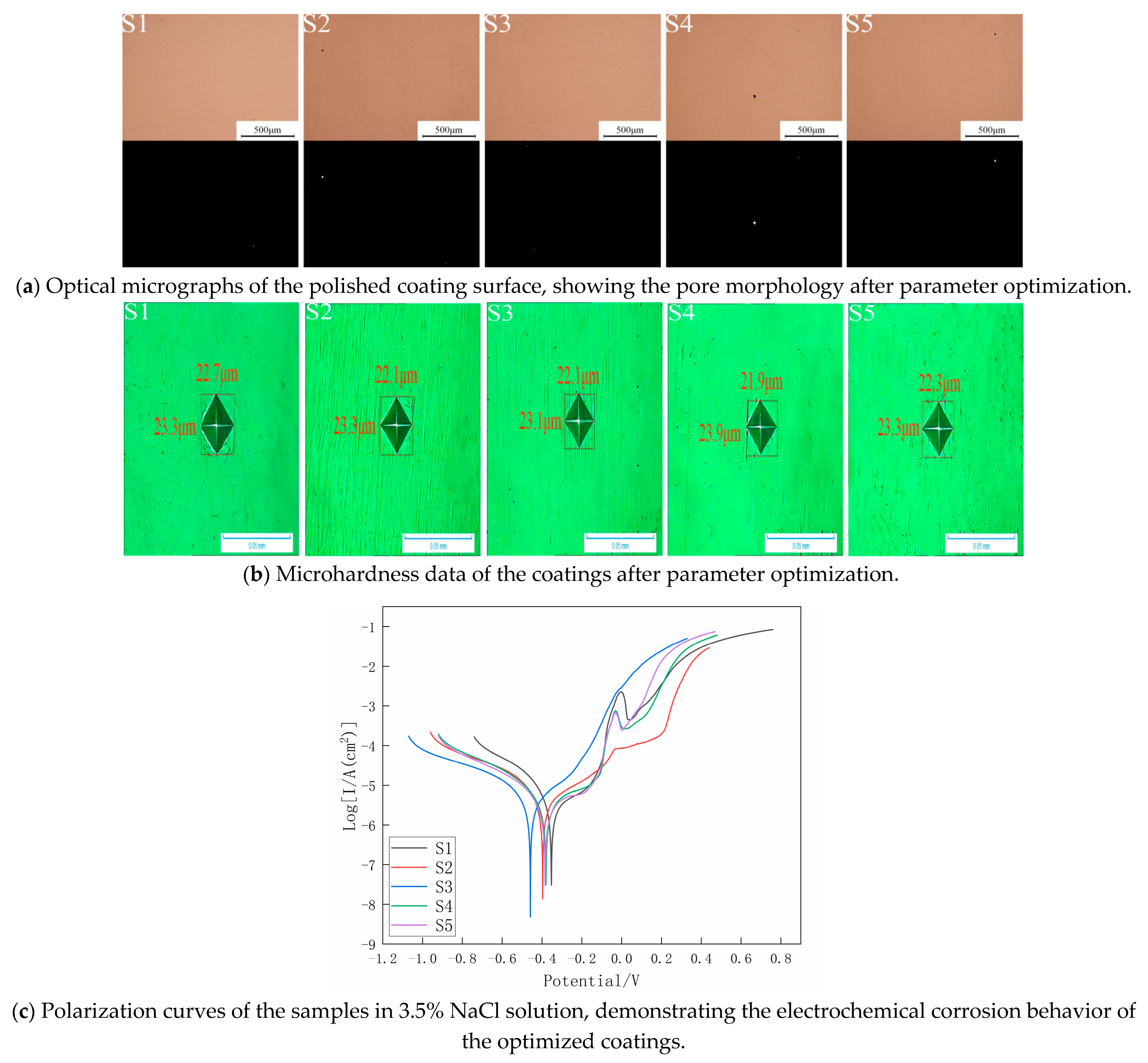
| 431SR | Fe 76~78 | C 0.18 | Cr 16.5 | Ni 1.75 | Other <5 |
| TC4 | Fe 0.15 | Ti 90 | Al 5.5 | V 3.5 | Other <1 |
| Factors and Levels | Laser Power/W | Scanning Speed (mm/s) | Amount of TC4 Addition/% |
|---|---|---|---|
| −1 | 4000 | 300 | 0 |
| 0 | 5000 | 350 | 2.5 |
| 1 | 6000 | 400 | 5 |
| No. | X1/W | X2 (mm/s) | X3/% | Y1/% | Y2/HV | Y3/Ω |
|---|---|---|---|---|---|---|
| S1 | 4000 | 350 | 0 | 0.26 | 727.6 | 2219 |
| S2 | 6000 | 350 | 0 | 0.17 | 747.8 | 2470 |
| S3 | 5000 | 300 | 0 | 0.24 | 683.6 | 2920 |
| S4 | 5000 | 400 | 0 | 0.39 | 754.7 | 1540 |
| S5 | 4000 | 300 | 2.5 | 0.21 | 529.1 | 4649 |
| S6 | 6000 | 300 | 2.5 | 0.12 | 606.8 | 4421 |
| S7 | 4000 | 400 | 2.5 | 0.07 | 702 | 3321 |
| S8 | 6000 | 400 | 2.5 | 0.19 | 555.2 | 3707 |
| S9 | 5000 | 350 | 2.5 | 0.08 | 638.1 | 4227 |
| S10 | 5000 | 350 | 2.5 | 0.09 | 643.5 | 4793 |
| S11 | 5000 | 350 | 2.5 | 0.06 | 649 | 4768 |
| S12 | 5000 | 350 | 2.5 | 0.05 | 627.4 | 5089 |
| S13 | 5000 | 350 | 2.5 | 0.12 | 632.7 | 4354 |
| S14 | 4000 | 350 | 5 | 0.05 | 369.8 | 6789 |
| S15 | 6000 | 350 | 5 | 0.13 | 338.5 | 6042 |
| S16 | 5000 | 300 | 5 | 0.27 | 336.6 | 6305 |
| S17 | 5000 | 400 | 5 | 0.07 | 367.4 | 7091 |
| Index | Variation Source | Sum of Squares | Freedom | F Values | p Values | |
|---|---|---|---|---|---|---|
| Y1 | Model | 0.15 | 9 | 32.90 | <0.0001 | Significant |
| Residual | 3.45 × 10−3 | 7 | / | / | ||
| Lack of Fit | 4.5 × 10−4 | 3 | 0.2 | 0.8914 | Not Significant | |
| Pure Error | 3 × 10−3 | 4 | / | / | ||
| X1X2 | 0.011 | 1 | 22.37 | 0.0021 | Significant | |
| X1X3 | 7.225 × 10−3 | 1 | 14.66 | 0.0065 | Significant | |
| X2X3 | 0.031 | 1 | 62.14 | 0.0001 | Significant | |
| Y2 | Model | 3.332 × 105 | 9 | 290.39 | <0.0001 | Significant |
| Residual | 892.33 | 7 | / | / | ||
| Lack of Fit | 600.72 | 3 | 2.75 | 0.1769 | Not Significant | |
| Pure Error | 291.61 | 4 | / | / | ||
| X1X2 | 12,600.06 | 1 | 98.84 | <0.0001 | Significant | |
| Y3 | Model | 3.974 × 107 | 9 | 34.81 | <0.0001 | Significant |
| Residual | 8.879 × 105 | 7 | / | / | ||
| Lack of Fit | 3.944 × 105 | 3 | 1.07 | 0.4572 | Not Significant | |
| Pure Error | 4.063 × 105 | 4 | / | / | ||
| X2X3 | 1.173 × 106 | 1 | 9.25 | 0.0188 | Significant |
| Elemental | Line Type | wt/% | wt/% Sigma | At/% |
|---|---|---|---|---|
| Al | K | 0.16 | 0.02 | 0.32 |
| Ti | K | 3.33 | 0.06 | 3.80 |
| V | K | 0.20 | 0.06 | 0.21 |
| Cr | L | 18.59 | 0.38 | 19.57 |
| Fe | L | 76.55 | 0.38 | 75.00 |
| Ni | L | 1.17 | 0.10 | 1.09 |
| Total | 100.00 | 100.00 |
| No. | Y1/% | Y2/HV | Y3/Ω |
|---|---|---|---|
| S1 | 0.01 | 702.0 | 13,912 |
| S2 | 0.02 | 721.1 | 11,127 |
| S3 | 0.02 | 727.6 | 13,780 |
| S4 | 0.03 | 708.3 | 11,499 |
| S5 | 0.02 | 714.6 | 13,494 |
Disclaimer/Publisher’s Note: The statements, opinions and data contained in all publications are solely those of the individual author(s) and contributor(s) and not of MDPI and/or the editor(s). MDPI and/or the editor(s) disclaim responsibility for any injury to people or property resulting from any ideas, methods, instructions or products referred to in the content. |
© 2025 by the authors. Licensee MDPI, Basel, Switzerland. This article is an open access article distributed under the terms and conditions of the Creative Commons Attribution (CC BY) license (https://creativecommons.org/licenses/by/4.0/).
Share and Cite
Hong, F.; Wei, T. Optimization of Multi-Objective Process Parameters and Performance Analysis of High-Speed Laser Cladding of TC4/AISI431 Composite Coatings. Coatings 2025, 15, 911. https://doi.org/10.3390/coatings15080911
Hong F, Wei T. Optimization of Multi-Objective Process Parameters and Performance Analysis of High-Speed Laser Cladding of TC4/AISI431 Composite Coatings. Coatings. 2025; 15(8):911. https://doi.org/10.3390/coatings15080911
Chicago/Turabian StyleHong, Fumin, and Tianlu Wei. 2025. "Optimization of Multi-Objective Process Parameters and Performance Analysis of High-Speed Laser Cladding of TC4/AISI431 Composite Coatings" Coatings 15, no. 8: 911. https://doi.org/10.3390/coatings15080911
APA StyleHong, F., & Wei, T. (2025). Optimization of Multi-Objective Process Parameters and Performance Analysis of High-Speed Laser Cladding of TC4/AISI431 Composite Coatings. Coatings, 15(8), 911. https://doi.org/10.3390/coatings15080911





